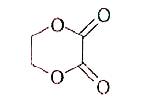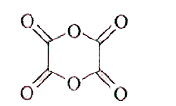When 1-butyne undergoes oxymercuraction with the help of HgSO4+H2SO4, the product(s) formed is/are
CH3CH2COOH+HCOOH
CH3CH2COCH3
CH3CH2CH2COOH
CH3CH2CH2CHO
The correct Answer is:B
To solve the question regarding the product formed when 1-butyne undergoes oxymercuration with the help of HgSO₄ and H₂SO₄, we can follow these steps:
1. Identify the Structure of 1-Butyne:
- The structure of 1-butyne is CH₃-CH₂-C≡C-H. It is an alkyne with a triple bond between the last two carbon atoms.
2. Understanding Oxymercuration:
- Oxymercuration involves the addition of mercuric ion (Hg²⁺) and water (from H₂SO₄) across the triple bond of the alkyne. The reaction will lead to the formation of an intermediate.
3. Formation of the Mercurinium Ion:
- The triple bond of 1-butyne donates its electrons to the mercuric ion (Hg²⁺), forming a mercurinium ion. The structure of this intermediate can be represented as:
- CH₃-CH₂-C(Hg)-C⁺
- Here, the mercuric ion is bonded to one of the carbon atoms of the former triple bond.
4. Nucleophilic Attack by Water:
- Water (H₂O) acts as a nucleophile and attacks the more substituted carbon of the mercurinium ion. This leads to the formation of an alcohol intermediate:
- CH₃-CH₂-C(OH)-C(Hg)
5. Tautomerization:
- The alcohol intermediate can undergo keto-enol tautomerism. The hydroxyl group (OH) can shift to form a carbonyl group (C=O), resulting in a ketone:
- CH₃-CH₂-C(=O)-CH₃ (butan-2-one)
6. Final Product:
- The final product of the reaction is butan-2-one (also known as methyl ethyl ketone).
Conclusion:
The product formed when 1-butyne undergoes oxymercuration with HgSO₄ and H₂SO₄ is butan-2-one.
- The structure of 1-butyne is CH₃-CH₂-C≡C-H. It is an alkyne with a triple bond between the last two carbon atoms.
- Oxymercuration involves the addition of mercuric ion (Hg²⁺) and water (from H₂SO₄) across the triple bond of the alkyne. The reaction will lead to the formation of an intermediate.
- The triple bond of 1-butyne donates its electrons to the mercuric ion (Hg²⁺), forming a mercurinium ion. The structure of this intermediate can be represented as:
- CH₃-CH₂-C(Hg)-C⁺
- Here, the mercuric ion is bonded to one of the carbon atoms of the former triple bond.
- Water (H₂O) acts as a nucleophile and attacks the more substituted carbon of the mercurinium ion. This leads to the formation of an alcohol intermediate:
- CH₃-CH₂-C(OH)-C(Hg)
- The alcohol intermediate can undergo keto-enol tautomerism. The hydroxyl group (OH) can shift to form a carbonyl group (C=O), resulting in a ketone:
- CH₃-CH₂-C(=O)-CH₃ (butan-2-one)
- The final product of the reaction is butan-2-one (also known as methyl ethyl ketone).
The product formed when 1-butyne undergoes oxymercuration with HgSO₄ and H₂SO₄ is butan-2-one.
Topper's Solved these Questions
- BOOK - NCERT FINGERTPS ENGLISHCHAPTER - HYDROCARBONS EXERCISE - Higher Order Thinkin Skills7videos
HYDROCARBONS
- BOOK - NCERT FINGERTPS ENGLISHCHAPTER - HYDROCARBONS EXERCISE - Assertion & Reason15videos
HYDROCARBONS
- BOOK - NCERT FINGERTPS ENGLISHCHAPTER - EQUILIBRIUM EXERCISE - Assertion And Reason15videos
EQUILIBRIUM
- BOOK - NCERT FINGERTPS ENGLISHCHAPTER - HYDROGEN EXERCISE - Assertion And Reason15videos
HYDROGEN
Similar Questions
Knowledge Check
- Question 1 - Select One
When ethylene glycol is heated with oxalic acid in the presence of conc. H2SO4, the product formed is :
A B
B C
C D
D
When KNO3 reacts with conc. H2SO4 products formed is/are:
View SolutionWhen SO2Cl2 reacts with H2O products formed is/are:
View SolutionWhen methyl alcohol is heated to 140∘C with conc. H2SO4, the product formed is :
View SolutionWhen 2-methyl-2-butanol is heated with conc . H2SO4 then main product formed is :
View SolutionEthyl alcohol is heated with conc. H2SO4at170∘C. The product formed is:
View SolutionThe product(s) obtained via oxymercuration (HgSO4+H2SO4) of 1-butyne would be:
View SolutionChlorobenzene reacts with trichloro acetaldehyde in the presence of H2SO4

The major product formed is :View Solution

